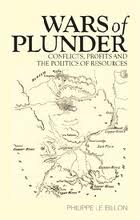|
Reviewed by Jan Záhořík, Ph.D., Department of History, University of West Bohemia, Pilsen, Czech Republic Although, due to a variety of reasons, many people tend to associate Africa with violence, disaster, disease, chaos, and famine, they are usually unable to place their thoughts within a broader context, which might provide a more balanced picture. The other side of Africa is that it is a continent very rich in natural resources, oil, diamonds, gold, coltan, timber, and many other commodities. In the past couple of decades, natural resources have played a remarkable role in a good number of conflicts and wars in many corners of the world. The new book written by Philippe Le Billon gives an excellent insight into these struggles over resources, not only in relation to oil. The author bases his findings on rich personal experiences from Angola, the Democratic Republic of Congo, Cambodia, the former Yugoslavia, Colombia, and Sierra Leone. However, it is not for these reasons alone that this book should be considered as a great piece of work. The monograph is divided into several chapters, of which the first two provide a broader theoretical insight into the motives and scope of the conflicts related to natural resources. It characterizes a wide range of the uses of resources with regard to warlordism, secessions, coups d’états, peasant wars, and foreign interventions. With the example of Angola, the author demonstrates one of the most common aspects of conflicts linked to natural resources, in this case diamonds. Jonas Savimbi’s UNITA was the type of organization that relied heavily on diamond financing, which enabled it to wrest vast territories of Angola from the control of the central government. What should be appreciated about “Wars of Plunder” is its broader perspective as the author puts his findings into their historical contexts when he shows how European powers exploited (not only) Africa. In other words, the resources of other continents helped the West to rise, especially over the last two centuries. Beside all other geopolitical and ideological contexts of the First and Second World Wars, these were in many cases motivated by the struggle for resources “and renewed vindictive claims among industrialized powers without colonies, chiefly Germany, Italy, and Japan.” The next three chapters are dedicated to three important resources, which according to the author have contributed the most to the emergence of conflicts, or at least have played a major role in them. These are oil, diamonds, and timber. No other natural resource is known for its “explosive” nature as oil. From Iraq, Iran through Libya, to Nigeria and Angola, we can see how oil became a commodity for which many wars have been waged and thousands of people have died. Oil, unlike some other resources, is not only one of the causes of wars, but can have a long-lasting impact on various societies in terms of ecological and environmental disasters. The author speaks about “slow death” in Ecuador, but it is the Niger Delta which is synonymous with ecological devastation, the degradation of agricultural land and massive (in many cases illegal) exploitation, which affects the lives of millions of local inhabitants. Such conditions may prolong wars and conflicts relatively easily as they have a direct impact on lives, societies and cultures in the affected areas. Oil companies can also be directly involved in conflicts, as has been shown in the example of Congo-Brazzaville, where the French oil company Elf supported Denis Sassou-Nguesso in 1997 against his rival Pascal Lissouba. French backing then helped Sassou-Nguesso to win the war and become President after a five-year break. Diamonds are usually associated with luxury and wealth. But because they belong to the class of easily “lootable” resources, their contribution to the prolongation of conflicts and war is obvious, as has been seen in Sierra Leone, Angola, and elsewhere. While the impact of oil and diamonds on conflicts and wars is quite obvious from the very beginning, one may be surprised a little by the role of timber, but as Le Billon shows in the examples of wars in Burma, Liberia, Cambodia, and the Solomon Islands, the environmental dimension of conflicts is crucial. Forests can, above many other things, serve as a good and effective “fortress” for any kind of insurgence movement or guerilla force as it may easily “stop cavalry and vehicles, provide cover to reduce the effectiveness of artillery or aerial bombardment, and facilitate ambush.” While starting a war can be relatively easy, reconstructing society and creating a peaceful atmosphere where resources and wealth can be redistributed equally throughout the population is much more difficult. In these circumstances, the UN Security Council and the International Court of Justice, can play a major part, as is shown with the examples of the Democratic Republic of Congo, Liberia, and some others. Philippe Le Billon’s book provides us with great insights into all aspects of “Wars of Plunder,” thus making it an important contribution to an understanding of the very complex relationships between resources and conflicts. |


 Wars of Plunder: Conflicts, Profits and the Politics of Resources
Wars of Plunder: Conflicts, Profits and the Politics of Resources